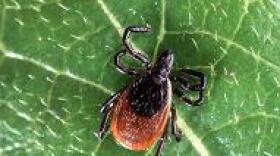Ticks are becoming more prevalent in the Northeast. An online seminar Wednesday evening offered information on identifying ticks, the diseases they carry, how to protect people, pets and livestock and how to manage landscapes to reduce the risk of ticks.
Ticks may be even more prevalent than you might think.
University of Vermont College of Agriculture and Life Sciences Research Assistant Professor and Entomologist Cheryl Frank Sullivan said a recent survey of Vermont farmers found only a quarter of respondents knew that ticks can be active year round.
“When we asked about how ticks and tick borne diseases have impacted them in their operations the top responses were that money was spent on personal protection and to treat themselves, family or pets for a suspected disease. And there is avoidance of working on their farm in areas where they knew ticks were most active and avoidance of recreating on their property in their spare time because of ticks,” Sullivan reported.” So clearly ticks are impacting our daily lives.”
Sullivan emphasized that ticks are not insects -- they are arachnids that can be found anywhere in the outdoor environment.
“Ticks seem to thrive just about anywhere and everywhere, from forests and grassy fields to urban parks and backyards. Ticks are very, very long lived. Their habitats can change based on host density, the time of year and this causes a real patchy distribution making finding them to target them for control very difficult,” Sullivan said.
Tick and tick-borne diseases are increasing, and Sullivan advised that tick checks should be done every day, especially in spring and fall.
“Ticks really love tight spaces. So you really want to check behind your ears, groin, under arms, behind knees, scalp and elsewhere. Using mirrors can help you get at those hard to see areas.” Sullivan added, “On animals they tend to be found in some common places, that being around the eyes and the ears, under the chin, between the front and hind leg and tail areas.”
What should you do if you find a tick?
“So if you find a tick, you want to use fine tip tweezers to remove it by grabbing it by the head close to the skin and pulling upward with a steady, even pressure. You do not want to squeeze it or crush it between your fingers,” Sullivan cautioned, “because that can increase the chances of that tick injecting pathogens into you. And then you want to clean that area with soap and water or alcohol. And you can either watch out for flu like symptoms or consult a physician.”
How about using animals that eat ticks as a control method? Sullivan said there have been inconclusive studies.
“It's like the possums. A lot of times you hear, Oh, we should just release possums all over the place to control the tick populations. Well, in fact, the whole thing with possums, it's not that they're actually going around vacuuming ticks up off the landscape. The possums are actually grooming themselves and they're eating the ticks off their bodies,” Sullivan said.
Both the adult and nymph stage of black-legged ticks can transmit Lyme Disease.
“My name is Linda, and I'm wondering if you might be able to touch on what they are doing with the Lyme vaccine.”
“They are in the final stages of that. But I will say the one thing about the Lyme vaccine for humans: don't let it be a false sense of security, because it is only for Lyme disease,” Sullivan emphasized. “A lot of these tick-borne illnesses you can have co-occurrences. You can get Anaplasmosis and Lyme disease or other things in combination with that.”
“Somewhat disappointing, but anyway, better than nothing,” Linda sighs.





























